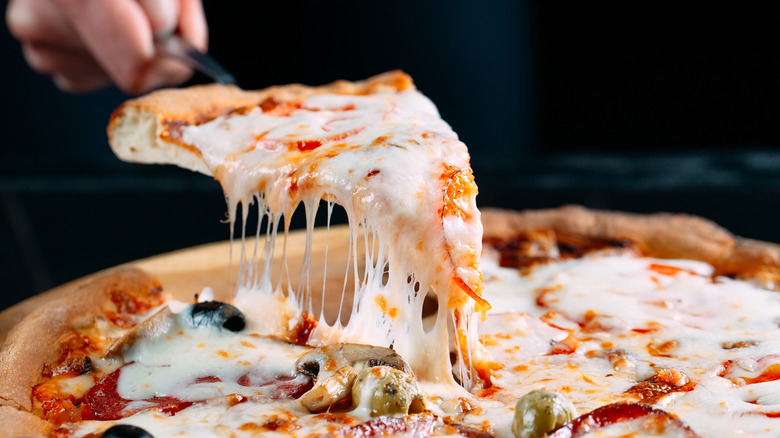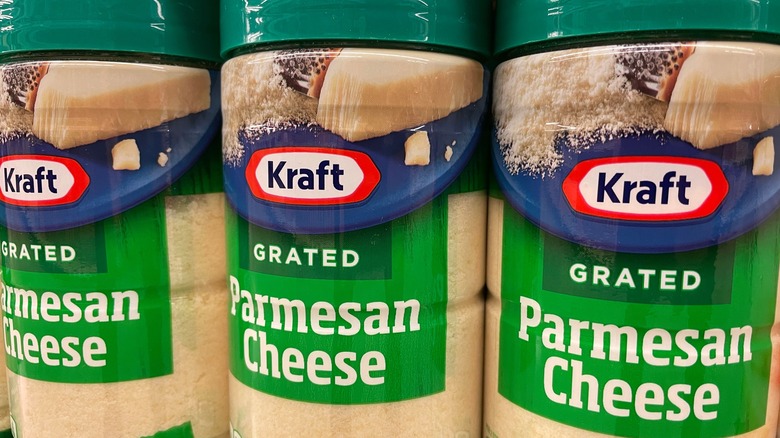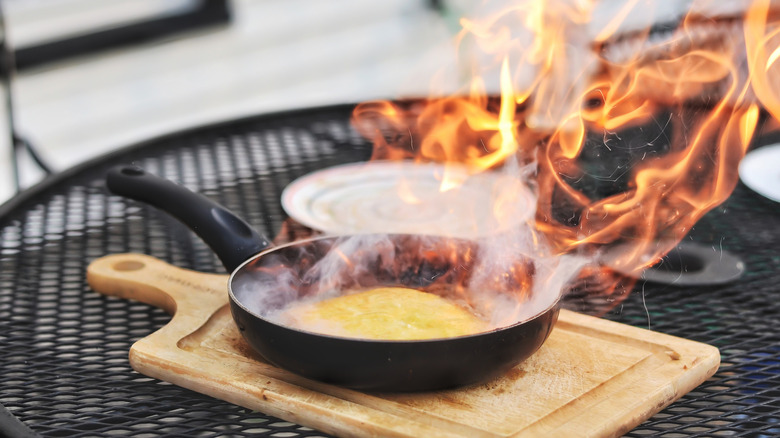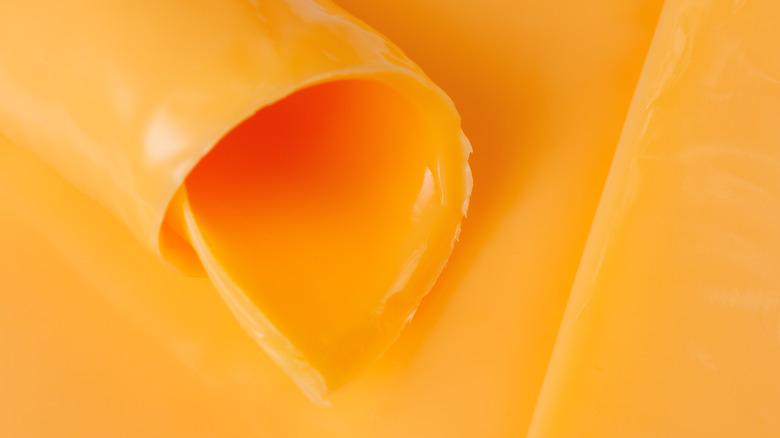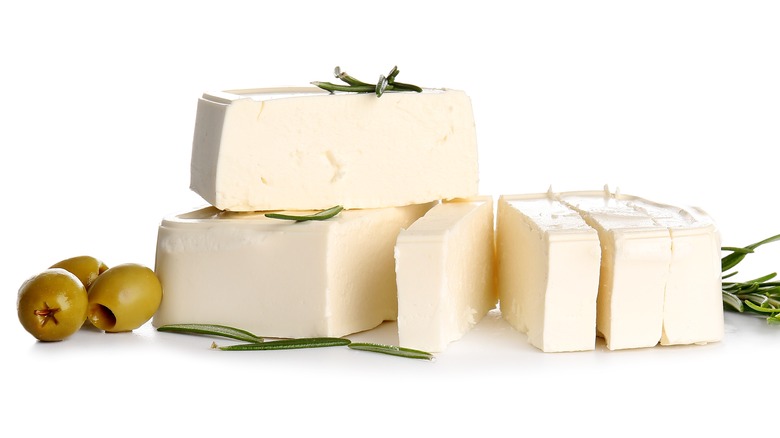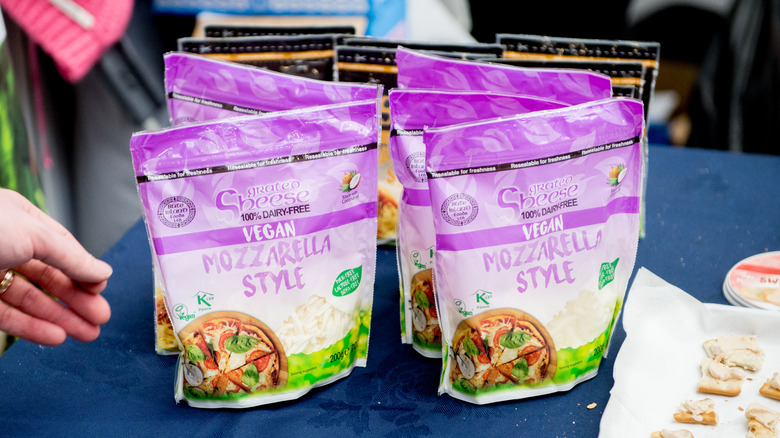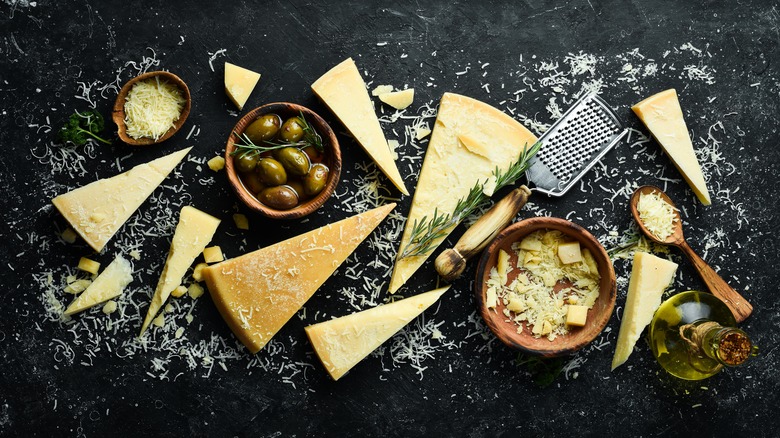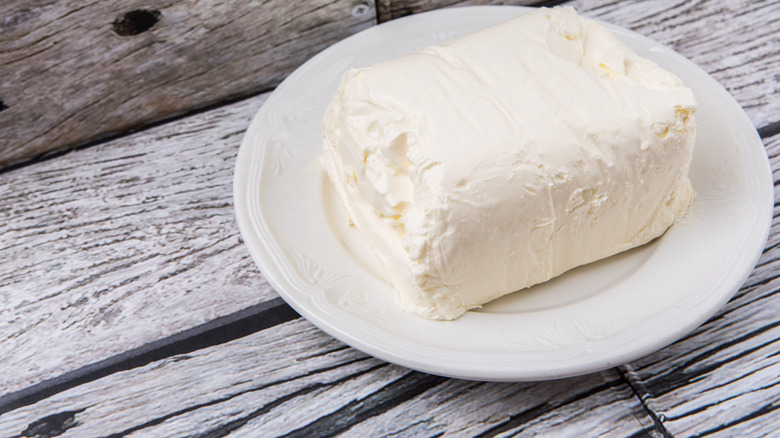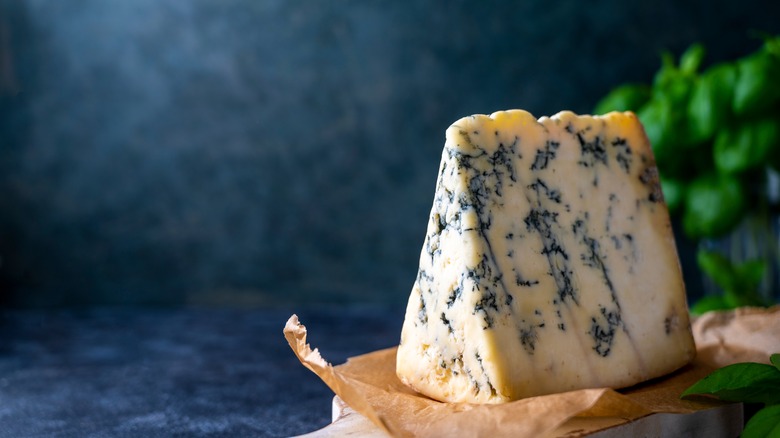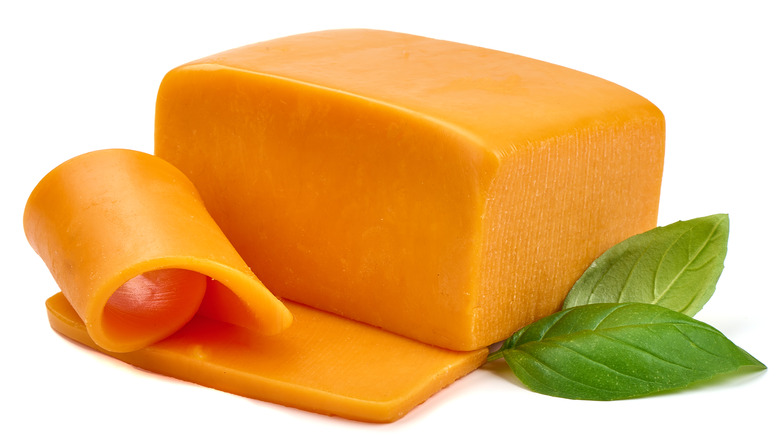Cheeses You Should Avoid Putting On Your Next Pizza
Cheese is one of the most universally beloved foods. Its adaptability and variability are truly miraculous and the bedrock of many great culinary traditions around the world. Whether it's made of cow, goat, or sheep milk, cheese can completely transform a dish. This is no less true of pizza. Cheese acts as the de facto glue binding the pizza toppings to the crust. Knowing which glue is going to create the perfect pie is integral to making a mind-blowing pizza.
So how does one know which cheese to choose for a pie and which ones to avoid? The decision comes down to science. There are five basic criteria to consider when looking at cheese options for your pizza, per Webstaurant Store: how well it browns without burning; how well it melts without becoming liquefied or clumpy; how stretchy or elastic it is; how high in fat it is (which will determine its texture as it melts); and how much moisture there is (which will directly impact its capacity to brown evenly).
The Atlantic boils it down to two basic rules of thumb. Low-moisture, high-fat cheeses will burn before the pie is completely cooked through. Conversely, high-moisture, high-fat cheeses will yield an oily mess that not only isn't browned or bubbly but coats your tongue with a thin film of fat rendering the texture of the pizza unpalatable. Based on these guidelines, we have determined the worst cheeses to use when making your own homemade pizza pie.
Pre-grated parmesan cheese
Store-bought, pre-grated parmesan cheese is arguably easy to use for a quick topping on literally everything. However, it is definitely not the best choice when topping a pizza. According to Foods Guy, at its most basic, pre-grated parmesan will not melt because it has undergone too much processing and is too finely ground. Even freshly-grated parmesan can be fickle in terms of melting due to the temperature at which it melts. However, when freshly grating high-quality parmesan cheese, one can accomplish a velvety, umami-filled mouthful of cheesy magic.
Foodiosity goes into further detail as to the factors that may prohibit pre-grated parmesan cheese from melting. Yet again, this has to do with science. Most pre-grated and pre-shredded parmesan cheese products are made with poor quality or even fake cheese that has been produced using acid to curdle the milk as opposed to rennet. Cheeses made with acid don't tend to melt well.
Additionally, these pre-grated and pre-shredded samples are mixed with an anti-caking agent like cornstarch, flour, or cellulose, which keeps the cheese from absorbing moisture and clumping together. Depending upon how much of this anti-caking agent has been added, the cheese may become gummy when heated and never melt. If you do opt for the real deal, select a parmesan with the PDO or Protected Designation of Origin label to ensure the highest possible quality. It's a bit pricier but well worth the cost.
Pre-shredded cheese
Pre-shredded cheeses of all kinds are definitely convenient, notably when large quantities of cheese are needed for a recipe and you are trying to protect yourself from developing cheese-grating-induced tennis elbow. However, there are definitely cons to using these products, especially where meltability is of primary concern. The anti-caking agents can adversely affect the final texture of a dish, particularly if you are attempting to melt the cheese.
Reader's Digest notes that it has to do with the quantity of the anti-caking agent added to the shredded cheese. The most commonly used type is cellulose and there is no guarantee as to the percentage of actual cheese versus cellulose you are getting in a bag of shredded cheese. Something that may seem like a cost-effective buy may end up being an expensive bag of cellulose.
The bottom line is that you should always grate your cheese fresh from the block to ensure quality as well as maximum meltability. There are some hacks for grating cheese that will help make it easier, such as using a food processor or spraying a box grater with cooking spray to keep the cheese from sticking to it. You can also freeze softer cheeses for 30 minutes prior to grating to help make the process even easier.
Grilling cheeses
If you've ever enjoyed a flaming heap of Saganaki at a Greek restaurant, you've eaten what is known as a grilling cheese. Lithuanian white cheese, queso fresco, juustoleipä or bread cheese, halloumi, and Indian paneer are just a few examples of this type of cheese, per Culture. The key factor for why these cheeses don't melt at high temperatures has to do with the protein in them. Grilling cheeses tend to have tightly-wound protein fibers that don't easily let go — meaning they retain a firm, chewy texture when heated.
For the most part, these types of cheeses are made using an acid technique rather than a rennet technique. When the milk is heated to a high temperature, vinegar, lemon juice, or another type of acid is added causing the curds to separate from the whey. The high heat enables the milk proteins — known as casein — to adhere to one another yielding a dense cheese. The one exception to this is Halloumi, which — although made using rennet — isn't allowed to process for as long a period of time as typical rennet-produced cheeses. This creates a cheese that is higher in acidity, thereby encouraging the proliferation of those dense protein nexuses. So unless you want a pizza with a squeaky layer of cheese between the crust and the toppings, you should probably avoid putting this type of grilling cheese on your pizza.
Processed American cheese
While processed American cheese does find its way into the culinary world thanks to its long shelf life, consistency, and unique melting properties, it isn't necessarily a great option for pizza, as we have discovered. Per Medicine Net, processed cheese is in fact made with real cheese — at least 51 percent of it to be exact. A combination of cheddar, Colby, and cheese curds is heated with an emulsifying agent and supplemented with a myriad of chemicals to reduce mold, tackiness, discoloration, and bacterial growth. Strictly from the vantage point of health, this highly-processed cheese-like specimen often contains excess levels of sodium and fat, which are potentially problematic for those at high risk for cardiovascular issues.
Health ramifications aside, if the purpose of using processed cheese is its meltability, then shouldn't it be the ideal topping for a great pie? Not exactly, as explained by Ripley's in an article about the most highly flammable cheeses. They set out to experiment by testing several different kinds of cheese for what's called the Maillard reaction — the process by which browning occurs when a food is subjected to heat. What they discovered was that due to the added chemicals and emulsifiers in American cheese, it is very unlikely to burn or even brown except under tremendous direct heat — like that of a blow torch. Since one of the fundamentals of a good pizza cheese is its ability to brown, this renders processed American cheese incompatible with a great pizza pie.
Sheep's milk cheeses
According to Insider's ranking of melting cheeses, sheep's milk cheeses make the worst melting cheese. They cite two factors that limit its capacity to become unctuous: its high protein content and its higher-than-average fat content. These cheeses typically hold their shape and ooze out fat — not altogether terrible, but certainly not ideal as a pizza topping.
Foodiosity goes into more detail with a cheese that is typically made with sheep's milk — feta. In addition to the high protein and fat content typical of sheep's milk cheeses, feta is also high in acidity and moisture. In fact, more than half of feta is water by weight, and about 19 percent of it is a specific type of acid — Pantothenic acid — which is known to have a disproportionately high melting point. Between all of these factors, as feta heats up, it basically steams, leaving a soft, creamy, slightly browned clump of cheese that —while delicious — isn't precisely what most pizzas call for. That being said, we have noted several pizza recipes that disregard this fact, favoring the unique salty flavor it imparts on the dish over its suitability as a perfect melting cheese.
Vegan cheese
While we in no way wish to malign the decision to go vegan — whether it be a dietary necessity or a personal decision — there is a very good reason that vegan cheese alternatives simply cannot be used as a one-to-one substitute for the real deal on a pizza. The thing that makes cheese melt so beautifully is the presence of the dairy protein casein. Most vegan alternatives may taste like actual cheese, but they tend to coagulate and remain somewhat chewy when heated.
Fear not, however, as Go Dairy Free has a number of suggestions for toppings that can have that depth of flavor cheese delivers without the gummy texture. They also point out that a dairy-free pizza may have the added benefit of being more cost-effective, as well as lower in sodium and saturated fat. Our favorite options include the mushroom pesto (which is loaded with umami flavors), roasted vegetables (which lend a delightful caramelized flavor), the Puttanesca-style sauce chock full of salty olives, and the Thai Curry sauce with peanuts. Each of these mimics some of the key characteristics of cheese that make it such a powerhouse element of the pizza experience.
Hard aged cheeses
According to The PHCheese, there is a basic rule of thumb that can be applied when you are staring at a cheese counter attempting to decipher which cheese to try on your next homemade pizza. For the most part, fresh cheeses that haven't been aged are much higher in moisture and tend to have more pliable sporadically-distributed protein molecules — known as casein — which make them ideal for melting. Harder aged cheeses will typically be dryer and — thanks to the aging process — the casein molecules will become densely packed, rendering them less likely to yield to the melting process.
This isn't necessarily always the case, as there are exceptions to this rule — think of a beautiful aged Parmesan cheese or a salty Pecorino Romano. Per Culture, the key is the size of the cheese granules added to the dish. A big chunk of parmesan, for example, will simply remain a big glob of fat when heated. But a finely-grated parmesan will yield to the heat, creating a delicate, velvety, melty texture. It's all about science and understanding the properties of cheese that help or hinder its capacity to melt.
Cream cheese
Cream cheese is a unique product in terms of its capacity to melt. While it is a high-fat, high-moisture cheese — which typically means it is ideal for melting — it is also a high-acid cheese, which usually makes it harder to melt. In other words, it's rather temperamental where melting is concerned. It can easily curdle if heated too rapidly, and once it is fully melted it will never thicken back up again.
Foods Guy notes that one must take extra care when melting cream cheese. If it's done too rapidly in the microwave, it'll become a watery, greasy mess. If it's done too rapidly over direct heat on the stovetop, it can easily burn. These two properties of cream cheese make it less than ideal as a topping for pizza. By the time the pizza is baked, the cream cheese will likely dissolve into a puddle of goo atop your pie, making the crust soggy and allowing the toppings to slide right off. It's best to reserve cream cheese for dishes like a luxurious carrot cake with cream cheese frosting or a dip like a cheese ball.
Strong-smelling cheese
Strong-smelling cheese is something that polarizes people into two camps: those who love them versus those who are revolted by them. But what makes these cheeses smell so aggressive? Culture enlightens us by dividing them into two categories: washed-rind cheeses and mold-injected cheeses.
Washed-rind cheeses are brushed with a brine typically made of leftover alcohol throughout the fermentation process. They are often the most foul-scented of cheeses due to bacterial proliferation, but their flavor tends to be quite mild. Mold-imparted cheeses — like blue cheese — are injected with varying strains of bacteria related to penicillin to encourage the mold to permeate throughout the entire block of cheese. These cheeses tend to be both strong-smelling and strong-tasting.
Smithsonian Magazine suggests that something about the direct link between the olfactory sense and our sense of taste triggers a disgust response similar to what we would experience when exposed to something that has gone rancid. While this may be a product of evolutionary adaptation that has long kept humans from eating potentially deadly foods, it does make one wonder why some people don't respond the same way. Is it nature or nurture? There may be a case for both. Certain cultures are more likely to grow up consuming stinky cheeses from a younger age, therefore exposing their citizens to the smelly cheeses and acculturating them to them. The jury is still out, but for the purposes of putting strong-odored cheese on pizza — we suggest you skip it.
Reduced fat cheese
Cheese is often vilified as being bad for your health, and perhaps to a certain extent, it can be if consumed in large quantities. However, according to a 2017 study by the American Journal of Clinical Nutrition (via Food & Wine), the idea that substituting low-fat or nonfat cheese options for the full-fat version to mitigate the negative health impacts is actually not supported by science. Researchers at the University of Copenhagen conducted a 12-week-long study cross-referencing those consuming no cheese, reduced-fat cheese, and full-fat cheese. Their findings were that cheese does not measurably influence any of the risk factors for cardiovascular disease. But more importantly, full-fat cheese was uniquely cited as having a positive influence on HDL cholesterol, which is linked to a reduced risk of experiencing a heart attack or stroke.
Culinary Nutrition (via Science Direct) both supports this and reinforces the culinary ramifications of opting for reduced-fat cheese — particularly for something like pizza. These cheeses not only take forever to melt, they often result in a chewy, dense texture making your pizza taste like cardboard. Like with anything else, consuming full-fat cheese in moderation where it counts — like on top of a delicious pizza — is not only more palatable but ultimately healthier.
Cheddar cheese
Scientific research conducted by the University of Auckland in New Zealand definitively answered the question of which cheese is the best on pizza. Their study sought to determine which cheese had the optimal Maillard reaction, yielding a perfectly browned layer of cheese atop a pizza. You can witness this process in action by gauging the bubbles created by the cheeses as they melt. The bubbles cannot be too large, too small, or too flat. In this endeavor, cameras were used to document the entire pizza-making process sampling a wide cross-section of different cheeses.
The end result was that cheddar lacked the necessary elasticity to properly melt — and its bubbles were too small to brown — making it an undesirable choice to top a pizza. Mozzarella was once and for all crowned the king of pizza cheeses thanks to its ideal ratio of moisture to oil. This gives it the perfect elasticity — which melts evenly — and yields the appropriate-sized bubbles to brown without burning. Frankly, we are sad that we were not a part of the research team who presumably had to sacrifice themselves to taste every sample in the name of science.
